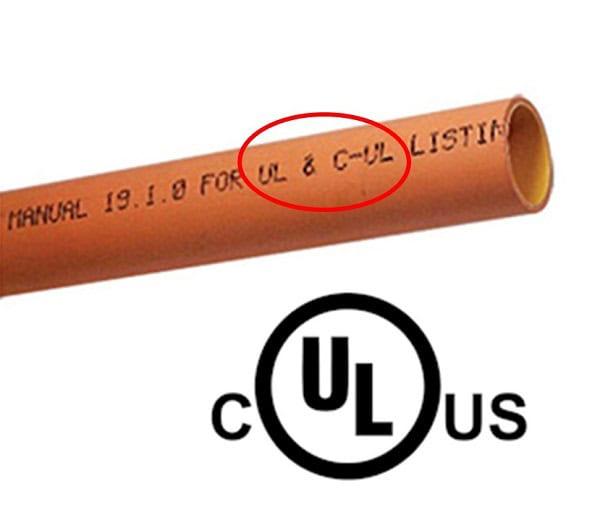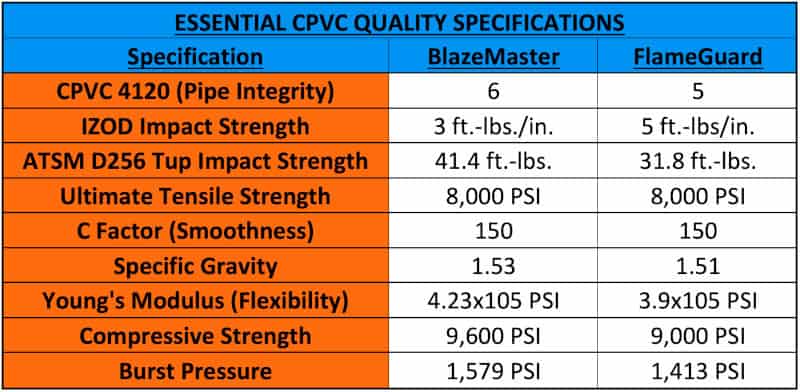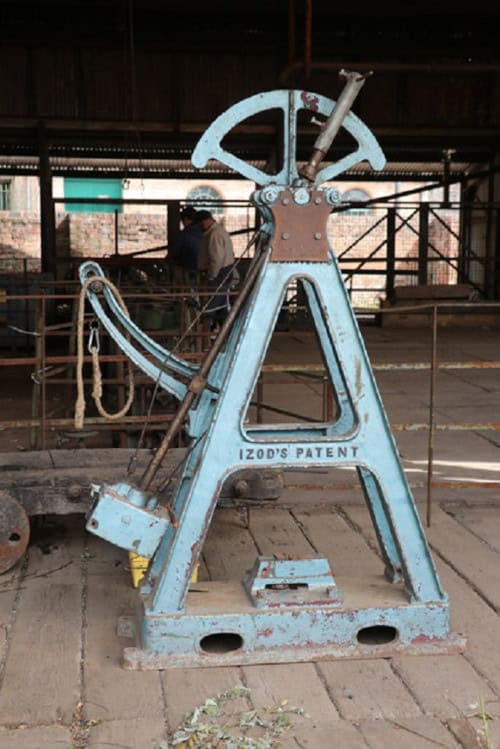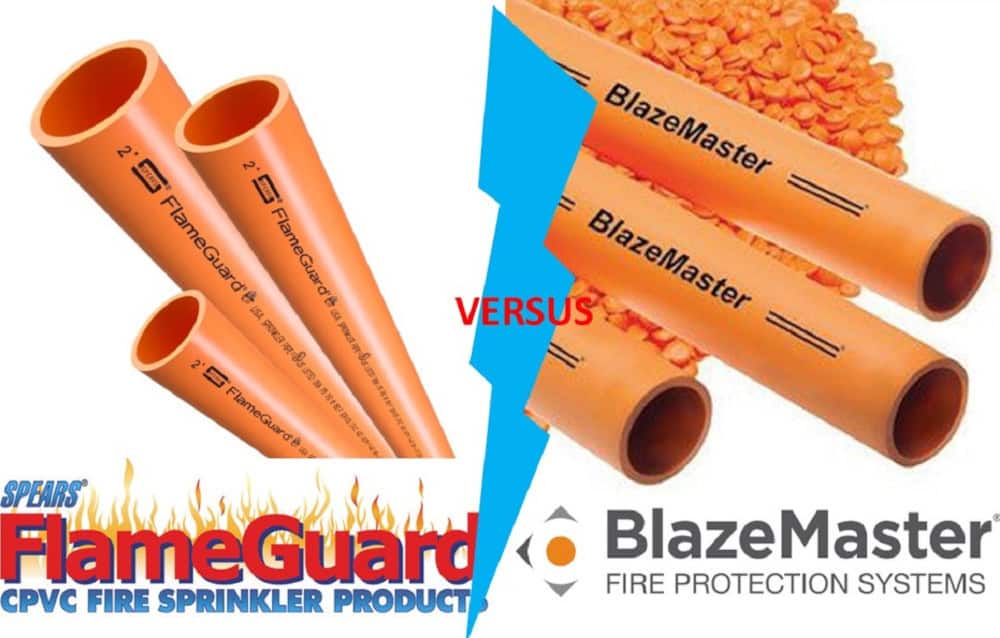Is all fire-rated orange pipe used in fire sprinkler systems equivalent?
CPVC pipes, whether they’re FlameGuard or BlazeMaster CPVC, are an excellent choice for fire sprinkler systems in settings where codes and standards allow their use. CPVC is lighter than metal pipe, flexible, easy to cut, easy to join, and exponentially less susceptible to corrosion.
Because it is a type of plastic (and plastic can melt if it gets hot enough), CPVC must be specially listed for fire protection before it can be employed in sprinkler systems, chiefly in light hazard and residential settings.
However, fire-rated CPVC pipes with this essential listing are not identical. Different manufacturers have specific recipes and processes that lead to slightly different products. Spears FlameGuard® and Lubrizol BlazeMaster® are two of the biggest names in the industry—so, what makes them unique?
This is your guide to the similarities and differences between FlameGuard and BlazeMaster CPVC. Read on to learn:
- Everything that’s identical about BlazeMaster, FlameGuard, and all fire-rated CPVC
- Some practical differences between the two brands, including:
Remember, these brands are listed for fire service—so they’re both tough and reliable. However, as we’ll see, the BlazeMaster pipe has a slight premium cost in exchange for slightly better material strength and fewer installation restrictions.
Need thermoplastic pipes and fittings? QRFS has FlameGuard CPVC pipe, fittings, and joint cement in stock and ready to ship, and we’ll soon carry BlazeMaster, too! Contact us for more information.
BlazeMaster and FlameGuard CPVC share many features
BlazeMaster and FlameGuard CPVC have a lot in common, as all fire-rated CPVC has to live up to certain standards. Here’s what’s the same:
- Chlorination. Manufacturers add chlorine to PVC to make CPVC, which stands for “chlorinated polyvinyl chloride.” The chlorine atoms give the pipe its extra durability and fire resistance. CPVC won’t burn unless it’s in direct and prolonged contact with flame.
- Smoothness. CPVC pipe is very smooth, with a friction coefficient (C-factor) of 150—the same as copper pipe. This is helpful during the hydraulic design of sprinkler systems because friction caused by the pipe walls ‘steals’ pressure and flow on the water’s way to the sprinklers. For a deeper dive into hydraulic calculations and how friction affects sprinkler design, read our previous blog: “How Much Water Pressure is Required for Fire Sprinkler Systems.”
- Nearly corrosion-free. While being as smooth as copper, CPVC has a major advantage over it and all metal pipes: aside from chemical or damage-induced stress corrosion (cracking), it doesn’t
- Chemical cement joints. Instead of using mechanical joints (like threads or grooved joints) or hard-to-create thermal welds, CPVC joins with chemical cement similar to that used for PVC.
- Wall thickness. All fire-rated CPVC has a ratio of wall thickness to pipe diameter—a measurement called Standard Dimension Ratio (SDR). No matter what size FlameGuard or BlazeMaster CPVC pipe you buy, it will always have an SDR of 13.5. Learn more about this number in our previous blog: “What Are SDR Pipe Measurements in CPVC Fire Sprinkler Pipe?”
- UL Listed. To be fire-rated, all CPVC pipe and fittings need to undergo a battery of tests prescribed in UL 1821: Standard for Thermoplastic Sprinkler Pipe and Fittings for Fire Protection Service (updated 2019). These use and abuse tests verify pressure resistance, resistance to temperature extremes, and more.
- Chemical caution. CPVC is a plastic polymer, which means it can react negatively to solvents and other chemicals used in construction. Each manufacturer publishes lists of compatible and incompatible chemicals and products. BlazeMaster’s list is here, and FlameGuard’s is here. You can read a more extensive write-up of this issue: “How to Avoid CPVC Pipe Problems Due to Chemical Incompatibilities.”

Comparing core FlameGuard and BlazeMaster specs
Since fire-rated CPVC needs to meet strict baseline quality standards to achieve a listing, it’s all good for use in fire sprinkler systems.
Whether you pick Lubrizol BlazeMaster or Spears FlameGuard pipe and fittings, you know you’re getting a quality, reliable product suitable for fire protection service. But to understand if one is better, we must drill down into detailed technical specs.
The sections below compare the hydrostatic design basis, impact strength, elasticity, burst pressure, and installation restrictions of BlazeMaster vs. FlameGuard CPVC. To do it, we’ll frequently refer to documents published by the American Society for Testing and Materials (ASTM).
This table summarizes the core specs of BlazeMaster and FlameGuard pipe. We explain many of these metrics in more detail below the table, skipping those that are identical or only differ slightly:

Hydrostatic design basis and CPVC 4120—pipe integrity over time and under pressure
Among all the specifications above, the hydrostatic design basis (modified to the hydrostatic design stress or HDS) is the least intuitive to understand but potentially the most useful.
The hydrostatic design basis is a score of pipe integrity over time. It is ultimately quantified by a CPVC 4120 code, which can either be 05 or 06. This score is determined by tests from ASTM D2837: Standard Test Method for Obtaining Hydrostatic Design Basis for Thermoplastic Pipe Materials or Pressure Design Basis for Thermoplastic Pipe Products (updated 2024). The assessments simulate long-term pipe usage.
The test goes like this: the pipe is filled with hot (180°F) water and pressurized for 16,000 hours (that’s almost two years). During this time, the hoop stress experienced by the pipe is measured and then extrapolated out to 100,000 hours (11.4 years). This value, which uses PSI units, is called the hydrostatic design basis. Divide that number by two (for a safety factor), and you get the hydrostatic design stress (HDS).
From the HDS, we finally get to the CPVC 4120 code. If a pipe achieves a minimum HDS of 500 PSI, it receives the 05 score. Most fire-rated CPVC pipe has this CPVC 4120 number. But if the pipe can hold out to 625 PSI, it earns a 06 score. BlazeMaster is the only CPVC in the fire industry with a 06 CPVC 4120 score, indicating its long-term reliability in the field.
BlazeMaster CPVC vs FlameGuard CPVC: Impact strength
Impact strength is precisely what it sounds like, describing how resilient the pipe is against strikes and drops. Pipes with a higher impact strength will hold up better on a job site and won’t accumulate as many micro-faults that might turn into failures later.
Spears and Lubrizol publish their pipes’ impact strength in terms of two tests: the Tup test and the Izod test.
Lubrizol likes to highlight data from a test described in ASTM D2444: Standard Practice for Determination of the Impact Resistance of Thermoplastic Pipe and Fittings by Means of a Tup (Updated 2021). In this test, a 12-lbs. weight called a “tup” is dropped on the sample pipe. Lubrizol beats Spears in this assessment, with its BlazeMaster 1” pipe having an impact strength of 41.4 FT-LBS against FlameGuard’s 31.8 FT-LBS.
But we’re not calling this one a total win for BlazeMaster. Another important industry test of impact strength is the IZOD Impact Strength test described in ASTM D256: Standard Test Methods for Determining the Izod Pendulum Impact Resistance of Plastics (updated 2023).
The IZOD test uses a swinging pendulum arm to strike notched samples. The rebound of the arm helps determine the amount of kinetic energy absorbed by the pipe at the moment it breaks. In this case, FlameGuard takes the W, with an IZOD score of 5 to BlazeMaster’s 3.

Elasticity
Elasticity is a very important property of plastic pipe. How much CPVC pipe can flex is a significant advantage over metal pipe. For example, it’s easier to maneuver a slightly flexible pipe during installation, and CPVC is allowed to be permanently installed in a slightly bent configuration rather than perfectly straight. Called deflection, this technique lets sprinkler fitters maneuver around obstacles without elbows. There are, of course, limits to how much you can deflect CPVC pipe.
Pipe flexibility is measured by Young’s Modulus, also called the Modulus of Elasticity. The higher Young’s Modulus is, the stiffer (and less flexible) the pipe is. BlazeMaster pipe has a higher Young’s Modulus than FlameGuard (4.23×105 versus 3.9×105)—therefore, BlazeMaster is less ‘bendy.’
In terms of practical applications, however, flexibility has little to no effect on how CPVC pipe is allowed to be used. Young’s Modulus doesn’t affect the permissible amount of deflection—despite having different flexibilities, BlazeMaster and FlameGuard can each be deflected the same amount. Young’s Modulus also does not impact the spacing of pipe hangers.
Burst Pressure
Burst pressure is just what it sounds like: the maximum pressure you can apply inside a pipe before it bursts. ASTM F442: Standard Specification for Chlorinated Poly(Vinyl Chloride) Plastic Pipe (updated 2023), contains the procedures for carrying out burst pressure tests.
Based on these tests, 1” BlazeMaster pipe bursts at 1,579 PSI, while Spears FlameGuard bursts at a lower pressure of 1,413 PSI—a difference of 166 PSI. Based on your specific application, you’ll have to decide the importance of that extra 166 PSI, but the working pressures of fire sprinkler systems are far below these numbers.
Installation rules for BlazeMaster CPVC vs FlameGuard CPVC
As a counterpoint to its convenience, fire-rated CPVC has more stringent National Fire Protection Association (NFPA) rules on where it can be installed than metallic pipe. All CPVC is primarily limited to light-hazard occupancies and residential settings. However, there are some differences between manufacturers.
First, BlazeMaster has a UL listing for embedding in concrete, while Spears FlameGuard does not. This gives BlazeMaster a slight edge in, for example, residential settings where a concrete slab foundation might be around piping.
Additionally, BlazeMaster has a broader use case in unfinished residential basements. Both pipe brands can be used in unfinished basements, but the allowable dimensions of joists differ. BlazeMaster is permitted for use when beams are 24″ apart on-center and make bays that are 40′ long and 16″ deep. Spears FlameGuard needs closer joist spacing (16” apart on-center) and smaller bays (32’ long x 12” deep).
So, which CPVC is better? FlameGuard or BlazeMaster?
Both Lubrizol’s BlazeMaster and Spears’ FlameGuard CPVC pipe and fittings are high-quality and reliable. They’re fire-rated, carrying UL listings indicating that they’ll hold up in the field when appropriately installed—so you can trust them for your fire sprinkler needs.
However, you have to make a choice based on the specific application and available resources.
Drilling down into the numbers: BlazeMaster pipe is generally tougher—it has a higher hydrostatic design basis and burst pressure rating. Lubrizol’s CPVC is also slightly more versatile in the field, with more permissive installation rules. In terms of impact resistance, the two pipes are roughly equal—it depends on which test you use to compare them. So, the choice often ultimately comes down to price point: FlameGuard will meet most needs, but BlazeMaster is the premium option.
QRFS carries the listed Spears FlameGuard CPVC pipe and fittings you need, and BlazeMaster products will also soon be live on our site. Contact us at 1-888-361-6662 or support@qrfs.com with questions or for help placing an order!
This blog was originally posted at blog.qrfs.com. If this article helped you, check us out at Facebook.com/QuickResponseFireSupply or on Twitter @QuickResponseFS.



